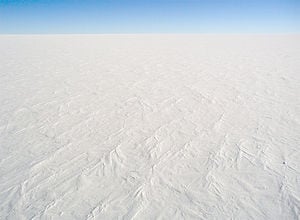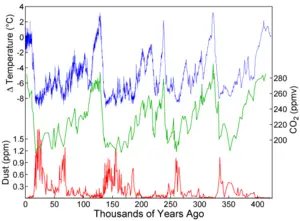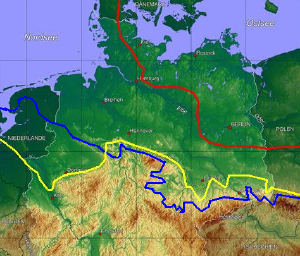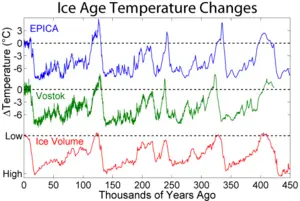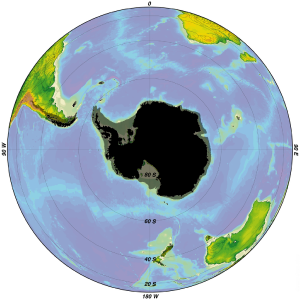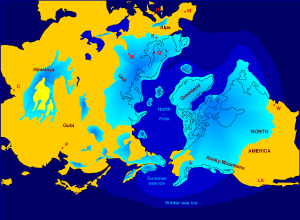- For the prehistoric era commonly referred to as The Ice Age, see the Pleistocene and the Paleolithic epoch.
The general term "ice age" or, more precisely, "glacial age" denotes a geological period of long-term reduction in the temperature of the Earth's surface and atmosphere, resulting in an expansion of continental ice sheets, polar ice sheets and alpine glaciers. Within a long-term ice age, individual pulses of extra cold climate are termed "glaciations." Glaciologically, ice age implies the presence of extensive ice sheets in the northern and southern hemispheres;[1] by this definition we are still in an ice age (because the Greenland and Antarctic ice sheets still exist).[2]
More colloquially, when speaking of the last few million years, "the" ice age refers to the most recent colder period with extensive ice sheets over the North American and Eurasian continents: in this sense, the most recent ice age peaked, in its Last Glacial Maximum about 20,000 years ago. This article will use the term ice age in the former, glaciological, sense: glacials for colder periods during ice ages and interglacials for the warmer periods.
Origin of ice age theory
The idea that in the past glaciers had been far more extensive was folk knowledge in some alpine regions of Europe: Imbrie and Imbrie (1979) quote a woodcutter by the name of Jean-Pierre Perraudin[3] telling Jean de Charpentier of the former extent of the Grimsel glacier in the Swiss Alps.[1] Macdougall (2004) claims the person was a Swiss engineer named Ignaz Venetz,[4] but no single person invented the idea.[5] Between 1825 and 1833, Charpentier assembled evidence in support of the concept. In 1836 Charpentier, Venetz and Karl Friedrich Schimper convinced Louis Agassiz, and Agassiz published the hypothesis in his book Étude sur les glaciers (Study on Glaciers) of 1840.[6] According to Macdougall (2004), Charpentier and Venetz disapproved of the ideas of Agassiz who extended their work claiming that most continents were once covered by ice.
At this early stage of knowledge, what was being studied were the glacial periods within the past few hundred thousand years, during the current ice age. The existence of ancient ice ages was as yet unsuspected.
Evidence for ice ages
There are three main types of evidence for ice ages: geological, chemical, and paleontological.
Geological evidence for ice ages comes in various forms, including rock scouring and scratching, glacial moraines, drumlins, valley cutting, and the deposition of till or tillites and glacial erratics. Successive glaciations tend to distort and erase the geological evidence, making it difficult to interpret. Furthermore, this evidence was difficult to date exactly; early theories assumed that the glacials were short compared to the long interglacials. The advent of sediment and ice cores revealed the true situation: glacials are long, interglacials short. It took some time for the current theory to be worked out.
The chemical evidence mainly consists of variations in the ratios of isotopes in fossils present in sediments and sedimentary rocks and ocean sediment cores. For the most recent glacial periods ice cores provide climate proxies from their ice, and atmospheric samples from included bubbles of air. Because water containing heavier isotopes has a higher heat of evaporation, its proportion decreases with colder conditions. This allows a temperature record to be constructed. However, this evidence can be confounded by other factors recorded by isotope ratios.
The paleontological evidence consists of changes in the geographical distribution of fossils. During a glacial period cold-adapted organisms spread into lower latitudes, and organisms that prefer warmer conditions become extinct or are squeezed into lower latitudes. This evidence is also difficult to interpret because it requires (1) sequences of sediments covering a long period of time, over a wide range of latitudes and which are easily correlated; (2) ancient organisms which survive for several million years without change and whose temperature preferences are easily diagnosed; and (3) the finding of the relevant fossils, which requires a lot of luck.
Despite the difficulties, analyses of ice core and ocean sediment cores has shown periods of glacials and interglacials over the past few million years. These also confirm the linkage between ice ages and continental crust phenomena such as glacial moraines, drumlins, and glacial erratics. Hence the continental crust phenomena are accepted as good evidence of earlier ice ages when they are found in layers created much earlier than the time range for which ice cores and ocean sediment cores are available.
Major ice ages
There have been at least four major ice ages in the Earth's past. Outside these periods, the Earth seems to have been ice-free even in high latitudes.
The earliest hypothesized ice age, called the Huronian, was around 2.7 to 2.3 billion years ago during the early Proterozoic Eon.
The earliest well-documented ice age, and probably the most severe of the last one billion years, occurred from 850 to 630 million years ago (the Cryogenian period) and may have produced a Snowball Earth in which permanent ice covered the entire globe and was ended by the effects of the accumulation of greenhouse gases such as CO2 produced by volcanoes. "The presence of ice on the continents and pack ice on the oceans would inhibit both silicate weathering and photosynthesis, which are the two major sinks for CO2 at present."[7] It has been suggested that the end of this ice age was responsible for the subsequent Ediacaran and Cambrian Explosion, though this theory is recent and controversial.
A minor ice age, the Andean-Saharan, occurred from 460 to 430 million years ago, during the Late Ordovician and the Silurian period. There were extensive polar ice caps at intervals from 350 to 260 million years ago, during the Carboniferous and early Permian Periods, associated with the Karoo Ice Age.
While an ice sheet on Antarctica began to grow some 20 million years ago, the current ice age is said to have started about 2.58 million years ago. During the late Pliocene the spread of ice sheets in the Northern Hemisphere began. Since then, the world has seen cycles of glaciation with ice sheets advancing and retreating on 40,000- and 100,000-year time scales called glacials (glacial advance) and interglacials (glacial retreat). The earth is currently in an interglacial, and the last glacial period ended about 10,000 years ago. All that remains of the continental ice sheets are the Greenland and Antarctic ice sheets.
Ice ages can be further divided by location and time; for example, the names Riss (180,000–130,000 years bp) and Würm (70,000–10,000 years bp) refer specifically to glaciation in the Alpine region. Note that the maximum extent of the ice is not maintained for the full interval. Unfortunately, the scouring action of each glaciation tends to remove most of the evidence of prior ice sheets almost completely, except in regions where the later sheet does not achieve full coverage. It is possible that glacial periods other than those above, especially in the Precambrian, have been overlooked because of scarcity of exposed rocks from high latitudes from older periods.
Glacials and interglacials
Within the ice ages (or at least within the last one), more temperate and more severe periods occur. The colder periods are called glacial periods, the warmer periods interglacials, such as the Eemian Stage.
Glacials are characterized by cooler and drier climates over most of the Earth and large land and sea ice masses extending outward from the poles. Mountain glaciers in otherwise unglaciated areas extend to lower elevations due to a lower snow line. Sea levels drop due to the removal of large volumes of water above sea level in the icecaps. There is evidence that ocean circulation patterns are disrupted by glaciations. Since the Earth has significant continental glaciation in the Arctic and Antarctic, we are currently in a glacial minimum of a glaciation. Such a period between glacial maxima is known as an interglacial.
The Earth has been in an interglacial period known as the Holocene for more than 11,000 years. It was conventional wisdom that "the typical interglacial period lasts about 12,000 years," but this has been called into question recently. For example, an article in Nature[8] argues that the current interglacial might be most analogous to a previous interglacial that lasted 28,000 years. Predicted changes in orbital forcing suggest that the next glacial period would begin at least 50,000 years from now, even in absence of human-made global warming (see Milankovitch cycles). Moreover, anthropogenic forcing from increased greenhouse gases might outweigh orbital forcing for as long as intensive use of fossil fuels continues[9]. At a meeting of the American Geophysical Union (December 17, 2008), scientists detailed evidence in support of the controversial idea that the introduction of large-scale rice agriculture in Asia, coupled with extensive deforestation in Europe began to alter world climate by pumping significant amounts of greenhouse gases into the atmosphere over the last 1000 years. In turn, a warmer atmosphere heated the oceans making them much less efficient storehouses of carbon dioxide and reinforcing global warming, possibly forestalling the onset of a new glacial age.[10]
Positive and negative feedbacks in glacial periods
Each glacial period is subject to positive feedback which makes it more severe and negative feedback which mitigates and (in all cases so far) eventually ends it.
Processes which make glacial periods more severe
Ice and snow increase the Earth's albedo, i.e. they make it reflect more of the sun's energy and absorb less. Hence, when the air temperature decreases, ice and snow fields grow, and this continues until an equilibrium is reached. Also, the reduction in forests caused by the ice's expansion increases albedo.
Another theory has hypothesized that an ice-free Arctic Ocean leads to increased snowfall at high latitudes. When low-temperature ice covers the Arctic Ocean there is little evaporation or sublimation and the polar regions are quite dry in terms of precipitation, comparable to the amount found in mid-latitude deserts. This low precipitation allows high-latitude snowfalls to melt during the summer. An ice-free Arctic Ocean absorbs solar radiation during the long summer days, and evaporates more water into the Arctic atmosphere. With higher precipitation, portions of this snow may not melt during the summer and so glacial ice can form at lower altitudes and more southerly latitudes, reducing the temperatures over land by increased albedo as noted above. (Current projected consequences of global warming include a largely ice-free Arctic Ocean within 5-20 years, see Arctic shrinkage.) Additional fresh water flowing into the North Atlantic during a warming cycle may also reduce the global ocean water circulation (see Shutdown of thermohaline circulation). Such a reduction (by reducing the effects of the Gulf Stream) would have a cooling effect on northern Europe, which in turn would lead to increased low-latitude snow retention during the summer. It has also been suggested that during an extensive ice age glaciers may move through the Gulf of Saint Lawrence, extending into the North Atlantic ocean to an extent that the Gulf Stream is blocked.
Processes which mitigate glacial periods
Ice sheets that form during glaciations cause erosion of the land beneath them. After some time, this will reduce land above sea level and thus diminish the amount of space on which ice sheets can form. This mitigates the albedo feedback, as does the lowering in sea level that accompanies the formation of ice sheets.
Another factor is the increased aridity occurring with glacial maxima, which reduces the precipitation available to maintain glaciation. The glacial retreat induced by this or any other process can be amplified by similar inverse positive feedbacks as for glacial advances.
Causes of ice ages
The causes of ice ages remain controversial for both the large-scale ice age periods and the smaller ebb and flow of glacial–interglacial periods within an ice age. The consensus is that several factors are important: atmospheric composition (the concentrations of carbon dioxide, methane); changes in the Earth's orbit around the Sun known as Milankovitch cycles (and possibly the Sun's orbit around the galaxy); the motion of tectonic plates resulting in changes in the relative location and amount of continental and oceanic crust on the Earth's surface, which could affect wind and ocean currents; variations in solar output; the orbital dynamics of the Earth-Moon system; and the impact of relatively large meteorites, and volcanism including eruptions of supervolcanoes.
Some of these factors influence each other. For example, changes in Earth's atmospheric composition (especially the concentrations of greenhouse gases) may alter the climate, while climate change itself can change the atmospheric composition (for example by changing the rate at which weathering removes CO2).
Maureen Raymo, William Ruddiman and others propose that the Tibetan and Colorado Plateaus are immense CO2 "scrubbers" with a capacity to remove enough CO2 from the global atmosphere to be a significant causal factor of the 40 million year Cenozoic Cooling trend. They further claim that approximately half of their uplift (and CO2 "scrubbing" capacity) occurred in the past 10 million years.[11][12]
Changes in Earth's atmosphere
There is evidence that greenhouse gas levels fell at the start of ice ages and rose during the retreat of the ice sheets, but it is difficult to establish cause and effect (see the notes above on the role of weathering). Greenhouse gas levels may also have been affected by other factors which have been proposed as causes of ice ages, such as the movement of continents and vulcanism.
The Snowball Earth hypothesis maintains that the severe freezing in the late Proterozoic was ended by an increase in CO2 levels in the atmosphere, and some supporters of Snowball Earth argue that it was caused by a reduction in atmospheric CO2. The hypothesis also warns of future Snowball Earths.
William Ruddiman has proposed the early anthropocene hypothesis, according to which the anthropocene era, as some people call the most recent period in the Earth's history when the activities of the human race first began to have a significant global impact on the Earth's climate and ecosystems, did not begin in the eighteenth century with the advent of the Industrial Era, but dates back to 8000 years ago, due to intense farming activities of our early agrarian ancestors. It was at that time that atmospheric greenhouse gas concentrations stopped following the periodic pattern of the Milankovitch cycles. In his overdue-glaciation hypothesis Ruddiman states that an incipient ice age would probably have begun several thousand years ago, but the arrival of that scheduled ice age was forestalled by the activities of early farmers.
Position of the continents
The geological record appears to show that ice ages start when the continents are in positions which block or reduce the flow of warm water from the equator to the poles and thus allow ice sheets to form. The ice sheets increase the Earth's reflectivity and thus reduce the absorption of solar radiation. With less radiation absorbed the atmosphere cools; the cooling allows the ice sheets to grow, which further increases reflectivity in a positive feedback loop. The ice age continues until the reduction in weathering causes an increase in the greenhouse effect.
There are three known configurations of the continents which block or reduce the flow of warm water from the equator to the poles:
- A continent sits on top of a pole, as Antarctica does today.
- A polar sea is almost land-locked, as the Arctic Ocean is today.
- A supercontinent covers most of the equator, as Rodinia did during the Cryogenian period.
Since today's Earth has a continent over the South Pole and an almost land-locked ocean over the North Pole, geologists believe that Earth will continue to endure glacial periods in the geologically near future.
Some scientists believe that the Himalayas are a major factor in the current ice age, because these mountains have increased Earth's total rainfall and therefore the rate at which CO2 is washed out of the atmosphere, decreasing the greenhouse effect.[12] The Himalayas' formation started about 70 million years ago when the Indo-Australian Plate collided with the Eurasian Plate, and the Himalayas are still rising by about 5 mm per year because the Indo-Australian plate is still moving at 67 mm/year. The history of the Himalayas broadly fits the long-term decrease in Earth's average temperature since the mid-Eocene, 40 million years ago.
Other important aspects which contributed to ancient climate regimes are the ocean currents, which are modified by continent position as well as other factors. They have the ability to cool (e.g. aiding the creation of Antarctic ice) and the ability to warm (e.g. giving the British Isles a temperate as opposed to a boreal climate). The closing of the Isthmus of Panama about 3 million years ago may have ushered in the present period of strong glaciation over North America by ending the exchange of water between the tropical Atlantic and Pacific Oceans.
Uplift of the Tibetan Plateau and surrounding mountain areas above the snowline
Matthias Kuhle's geological theory of Ice Age development was suggested by the possible existence of an ice sheet covering the Tibetan plateau during the Ice Ages. The plate-tectonic uplift of Tibet past the snowline has led to an approximately 2.4 million km² ice surface with a 70 percent greater albedo than the bare land surface. The reflection of energy into space resulted in a global cooling, triggering the Pleistocene Ice Age. Because this highland is at a subtropical latitude, with 4 to 5 times the insolation of high-latitude areas, what would be Earth's strongest heating surface has turned into a cooling surface.
Kuhle explains the interglacial periods by the 100,000-year cycle of radiation changes due to variations of the Earth's orbit. This comparatively insignificant warming, when combined with the lowering of the Nordic inland ice areas and Tibet due to the weight of the superimposed ice-load, has led to the repeated complete thawing of the inland ice areas.[13][14][15]
Variations in Earth's orbit (Milankovitch cycles)
The Milankovitch cycles are a set of cyclic variations in characteristics of the Earth's orbit around the sun. Each cycle has a different length, so at some times their effects reinforce each other and at other times they (partially) cancel each other.
It is very unlikely that the Milankovitch cycles can start or end an ice age (series of glacial periods):
- Even when their effects reinforce each other they are not strong enough.
- The "peaks" (effects reinforce each other) and "troughs" (effects cancel each other) are much more regular and much more frequent than the observed ice ages.
In contrast, there is strong evidence that the Milankovitch cycles affect the occurrence of glacial and interglacial periods within an ice age. The present ice ages are the most studied and best understood, particularly the last 400,000 years, since this is the period covered by ice cores that record atmospheric composition and proxies for temperature and ice volume. Within this period, the match of glacial/interglacial frequencies to the Milanković orbital forcing periods is so close that orbital forcing is generally accepted. The combined effects of the changing distance to the Sun, the precession of the Earth's axis, and the changing tilt of the Earth's axis redistribute the sunlight received by the Earth. Of particular importance are changes in the tilt of the Earth's axis, which affect the intensity of seasons. For example, the amount of solar influx in July at 65 degrees north latitude varies by as much as 25 percent (from 400 W/m² to 500 W/m², see graph at [2]). It is widely believed that ice sheets advance when summers become too cool to melt all of the accumulated snowfall from the previous winter. Some workers believe that the strength of the orbital forcing is too small to trigger glaciations, but feedback mechanisms like CO2 may explain this mismatch.
While Milankovitch forcing predicts that cyclic changes in the Earth's orbital parameters can be expressed in the glaciation record, additional explanations are necessary to explain which cycles are observed to be most important in the timing of glacial–interglacial periods. In particular, during the last 800,000 years, the dominant period of glacial–interglacial oscillation has been 100,000 years, which corresponds to changes in Earth's eccentricity and orbital inclination. Yet this is by far the weakest of the three frequencies predicted by Milankovitch. During the period 3.0–0.8 million years ago, the dominant pattern of glaciation corresponded to the 41,000-year period of changes in Earth's obliquity (tilt of the axis). The reasons for dominance of one frequency versus another are poorly understood and an active area of current research, but the answer probably relates to some form of resonance in the Earth's climate system.
The "traditional" Milankovitch explanation struggles to explain the dominance of the 100,000-year cycle over the last eight cycles. Richard A. Muller and Gordon J. MacDonald [3] [4] [5] and others have pointed out that those calculations are for a two-dimensional orbit of Earth but the three-dimensional orbit also has a 100,000-year cycle of orbital inclination. They proposed that these variations in orbital inclination lead to variations in insolation, as the earth moves in and out of known dust bands in the solar system. Although this is a different mechanism to the traditional view, the "predicted" periods over the last 400,000 years are nearly the same. The Muller and MacDonald theory, in turn, has been challenged by Jose Antonio Rial[16]
Another worker, William Ruddiman, has suggested a model that explains the 100,000-year cycle by the modulating effect of eccentricity (weak 100,000-year cycle) on precession (23,000-year cycle) combined with greenhouse gas feedbacks in the 41,000- and 23,000-year cycles. Yet another theory has been advanced by Peter Huybers who argued that the 41,000-year cycle has always been dominant, but that the Earth has entered a mode of climate behavior where only the second or third cycle triggers an ice age. This would imply that the 100,000-year periodicity is really an illusion created by averaging together cycles lasting 80,000 and 120,000 years. This theory is consistent with the existing uncertainties in dating, but not widely accepted at present[17]
Variations in the Sun's energy output
There are at least two types of variation in the Sun's energy output:
- In the very long term, astrophysicists believe that the sun's output increases by about 10% per billion (109) years. In about one billion years the additional 10% will be enough to cause a runaway greenhouse effect on Earth—rising temperatures produce more water vapor, water vapor is a greenhouse gas (much stronger than CO2), the temperature rises, more water vapor is produced, etc.
- Shorter-term variations, some possibly caused by hunting. Since the Sun is huge, the effects of imbalances and negative feedback processes take a long time to propagate through it, so these processes overshoot and cause further imbalances, etc.—"long time" in this context means thousands to millions of years.
The long-term increase in the Sun's output cannot be a cause of ice ages.
The best known shorter-term variations are sunspot cycles, especially the Maunder minimum, which is associated with the coldest part of the Little Ice Age. Like the Milankovitch cycles, sunspot cycles' effects are too weak and too frequent to explain the start and end of ice ages but very probably help to explain temperature variations within them.
Volcanism
It is theoretically possible that undersea volcanoes could end an ice age by causing global warming. One suggested explanation of the Paleocene-Eocene Thermal Maximum is that undersea volcanoes released methane from clathrates and thus caused a large and rapid increase in the greenhouse effect. There appears to be no geological evidence for such eruptions at the right time, but this does not prove they did not happen.
It is challenging to see how volcanism could cause an ice age, since its cooling effects would have to be stronger than, and to outlast, its warming effects. This would require dust and aerosol clouds which would stay in the upper atmosphere blocking the sun for thousands of years, which seems very unlikely. Undersea volcanoes could not produce this effect because the dust and aerosols would be absorbed by the sea before they reached the atmosphere.
Recent glacial and interglacial phases
Glacial stages in North America
The major glacial stages of the current ice age in North America are the Illinoian, Sangamonian and Wisconsin stages. The use of the Nebraskan, Afton, Kansan, and Yarmouthian (Yarmouth) stages to subdivide the ice age in North America have been discontinued by Quaternary geologists and geomorphologists. These stages have all been merged into the Pre-Illinoian Stage in the 1980s.[18][19][20]
During the most recent North American glaciation, during the latter part of the Wisconsin Stage (26,000 to 13,300 years ago), ice sheets extended to about 45 degrees north latitude. These sheets were 3 to 4 km thick.[19]
This Wisconsin glaciation left widespread impacts on the North American landscape. The Great Lakes and the Finger Lakes were carved by ice deepening old valleys. Most of the lakes in Minnesota and Wisconsin were gouged out by glaciers and later filled with glacial meltwaters. The old Teays River drainage system was radically altered and largely reshaped into the Ohio River drainage system. Other rivers were dammed and diverted to new channels, such as the Niagara, which formed a dramatic waterfall and gorge, when the waterflow encountered a limestone escarpment. Another similar waterfall, at the present Clark Reservation State Park near Syracuse, New York, is now dry.
The area from Long Island to Nantucket was formed from glacial till, and the plethora of lakes on the Canadian Shield in northern Canada can be almost entirely attributed to the action of the ice. As the ice retreated and the rock dust dried, winds carried the material hundreds of miles, forming beds of loess many dozens of feet thick in the Missouri Valley. Isostatic rebound continues to reshape the Great Lakes and other areas formerly under the weight of the ice sheets.
The Driftless Zone, a portion of western and southwestern Wisconsin along with parts of adjacent Minnesota, Iowa, and Illinois, was not covered by glaciers.
Effects of glaciation
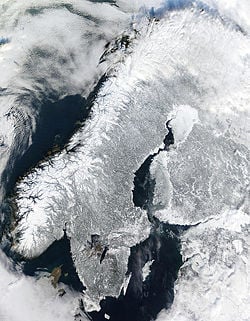
Although the last glacial period ended more than 8,000 years ago, its effects can still be felt today. For example, the moving ice carved out landscape in Canada, Greenland, northern Eurasia and Antarctica. The erratic boulders, till, drumlins, eskers, fjords, kettle lakes, moraines, cirques, horns, etc., are typical features left behind by the glaciers.
The weight of the ice sheets was so great that they deformed the earth's crust and mantle. After the ice sheets melted, the ice-covered land rebounded (see Post-glacial rebound). Due to the high viscosity of the Earth, the flow of mantle rocks which controls the rebound process is very slow – at a rate of about 1 cm/year near the center of rebound today.
During glaciation, water was taken from the oceans to form the ice at high latitudes, thus global sea level drops by about 120 meters, exposing the continental shelves and forming land-bridges between land-masses for animals to migrate. During deglaciation, the melted ice-water returned to the oceans, causing sea level to rise. This process can cause sudden shifts in coastlines and hydration systems resulting in newly submerged lands, emerging lands, collapsed ice dams resulting in salination of lakes, new ice dams creating vast areas of freshwater, and a general alteration in regional weather patterns on a large but temporary scale. It can even cause temporary reglaciation. This type of chaotic pattern of rapidly changing land, ice, saltwater and freshwater has been proposed as the likely model for the Baltic and Scandinavian regions, as well as much of central North America at the end of the last glacial maximum, with the present-day coastlines only being achieved in the last few millennia of prehistory. Also, the effect of elevation on Scandinavia submerged a vast continental plain that had existed under much of what is now the North Sea, connecting the British Isles to Continental Europe.
The redistribution of ice-water on the surface of the Earth and the flow of mantle rocks causes the gravitational field and the moment of inertia of the Earth to change. Changes in the moment of inertia result in a change in the rotational motion of the Earth (see Post-glacial rebound).
The weight of the redistributed surface mass loaded the lithosphere, causes it to flexure and also induced stress within the Earth. The presence of the glaciers generally suppress the movement of faults below (Johnston 1989, Wu & Hasegawa 1996, Turpeinen et al. 2008). However, during deglaciation, the faults experience accelerated slip and earthquakes are triggered (see Post-glacial rebound). Earthquakes triggered near the ice margin may in turn accelerate ice calving and may account for the Heinrich events (Hunt & Malin 1998). As more ice are removed near the ice margin, more intraplate earthquakes are induced and this positive feedback may explain the fast collapse of ice sheets.
| |||||||||||||||||
See also
- Irish Sea Glacier
- Little ice age
- Post-glacial rebound
- Timeline of glaciation
- Global cooling
Notes
- ↑ 1.0 1.1 J. Imbrie and K.P. Imbrie. 1979. Ice Ages: Solving the Mystery. (Short Hills, NJ: Enslow Publishers. ISBN 9780894900204).
- ↑ J. Gribbin. 1982. Future weather and the greenhouse effect. (New York, NY: Delacorte Press/Eleanor Friede. ISBN 9780440024989.)
- ↑ Die Eiszeit…, 3. Museum of Neuchatel, Switzerland. Retrieved February 19, 2009.
- ↑ Doug Macdougall. 2004. Frozen Earth: The Once and Future Story of Ice Ages. (Berkeley, CA: University of California Press. ISBN 0520248244).
- ↑ Aber Sandusky, James. Birth of the Glacial Theory. Emporia State University. Retrieved February 19, 2009.
- ↑ Louis Agassiz. 1840. Études sur les glaciers. (Neuchâtel, CH: L'auteur; Soleure, CH: Jent et Gassmann.)
- ↑ Chris Clowes, Cryogenian Snowballs. palaeos.com. Retrieved February 19, 2009.
- ↑ EPICA community members. 2004. Eight glacial cycles from an Antarctic ice core. Nature. 429:623.
- ↑ Next Ice Age Delayed By Rising Carbon Dioxide Levels. ScienceDaily. Retrieved February 19, 2009.
- ↑ Did Early Climate Impact Divert a New Glacial Age? Newswise. Retrieved February 19, 2009.
- ↑ Ruddiman, W.F. and J.E. Kutzbach. 1991. Plateau Uplift and Climate Change. Scientific American. 264:66-74.
- ↑ 12.0 12.1 Raymo, M.E., W.F. Ruddiman, and P.N. Froelich. 1988. Influence of late Cenozoic mountain building on ocean geochemical cycles. Geology. 16:649-653.
- ↑ Kuhle, M. 1988. The Pleistocene Glaciation of Tibet and the Onset of Ice Ages- An Autocycle Hypothesis. GeoJournal 17(4, Tibet and High-Asia. Results of the Sino-German Joint Expeditions I.):581-596.
- ↑ Kuhle, M., J. Ehlers, and P.L. Gibbard eds. 2004. The High Glacial (Last Ice Age and LGM) ice cover in High and Central Asia. Development in Quaternary Science 2c(Quaternary Glaciation - Extent and Chronology, Part III: South America, Asia, Africa, Australia, Antarctica):175-199.
- ↑ Kuhle, M. 2007. The Past Ice Stream Network in the Himalayas and the Tibetan Ice Sheet during the Last Glacial Period and its glacial-isostatic, eustatic and climatic consequences. Tectonophysics. 445(1-2):116-144.
- ↑ J. A. Rial. Pacemaking the Ice Ages by Frequency Modulation of Earth's Orbital Eccentricity. [1]. pangea. Stanford University. Retrieved February 25, 2009.
- ↑ Peter Huybers & Carl Wunsch, "Obliquity pacing of the late Pleistocene glacial terminations." Nature 434, (2005).
- ↑ G.R. Hallberg, 1986. Pre-Wisconsin glacial stratigraphy of the Central Plains region in Iowa, Nebraska, Kansas, and Missouri. Quaternary Science Reviews 5:11-15.
- ↑ 19.0 19.1 G.M. Richmond and D.S. Fullerton. 1986. Summation of Quaternary glaciations in the United States of America. Quaternary Science Reviews 5:183-196.
- ↑ P.L. Gibbard, S. Boreham, K.M. Cohen, and A. Moscariello. 2007. Global chronostratigraphical correlation table for the last 2.7 million years v. 2007b. Subcommission on Quaternary Stratigraphy, Department of Geography, University of Cambridge, Cambridge, UK. Retrieved February 19, 2009.
ReferencesISBN links support NWE through referral fees
- Gribbin, J. 1982. Future weather and the greenhouse effect. New York, NY: Delacorte Press/Eleanor Friede. ISBN 9780440024989.
- Hallberg, G.R. 1986. Pre-Wisconsin glacial stratigraphy of the Central Plains region in Iowa, Nebraska, Kansas, and Missouri. Quaternary Science Reviews 5:11-15.
- Imbrie, J., and K.P. Imbrie. 1979. Ice Ages: Solving the Mystery. Short Hills, NJ: Enslow Publishers. ISBN 9780894900204.
- Kuhle, M. 2007. The Past Ice Stream Network in the Himalayas and the Tibetan Ice Sheet during the Last Glacial Period and its glacial-isostatic, eustatic and climatic consequences. Tectonophysics 445(1-2):116-144.
- Macdougall, Doug. 2004. Frozen Earth: The Once and Future Story of Ice Ages. Berkeley, CA: University of California Press. ISBN 0520248244.
- Raymo, M.E., W.F. Ruddiman, and P.N. Froelich. 1988. Influence of late Cenozoic mountain building on ocean geochemical cycles. Geology 16:649-653.
- Richmond, G.M., and D.S. Fullerton, 1986, Summation of Quaternary glaciations in the United States of America. Quaternary Science Reviews. 5:183-196.
- Ruddiman, W.F., and J.E. Kutzbach. 1991. Plateau Uplift and Climate Change. Scientific American 264:66-74.
External links
All links retrieved January 25, 2018.
- Cracking the Ice Age from PBS.
Credits
New World Encyclopedia writers and editors rewrote and completed the Wikipedia article in accordance with New World Encyclopedia standards. This article abides by terms of the Creative Commons CC-by-sa 3.0 License (CC-by-sa), which may be used and disseminated with proper attribution. Credit is due under the terms of this license that can reference both the New World Encyclopedia contributors and the selfless volunteer contributors of the Wikimedia Foundation. To cite this article click here for a list of acceptable citing formats.The history of earlier contributions by wikipedians is accessible to researchers here:
The history of this article since it was imported to New World Encyclopedia:
Note: Some restrictions may apply to use of individual images which are separately licensed.
